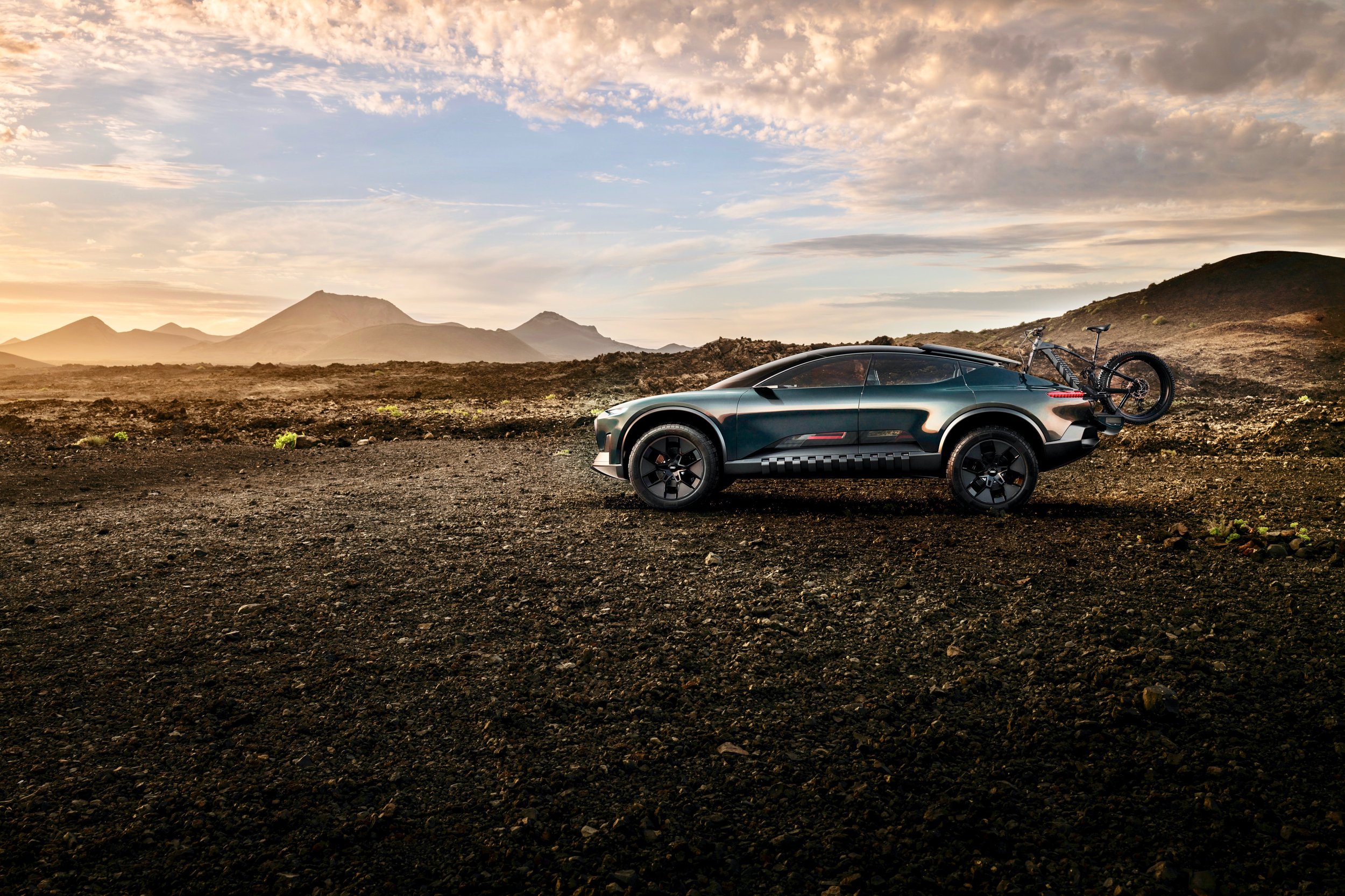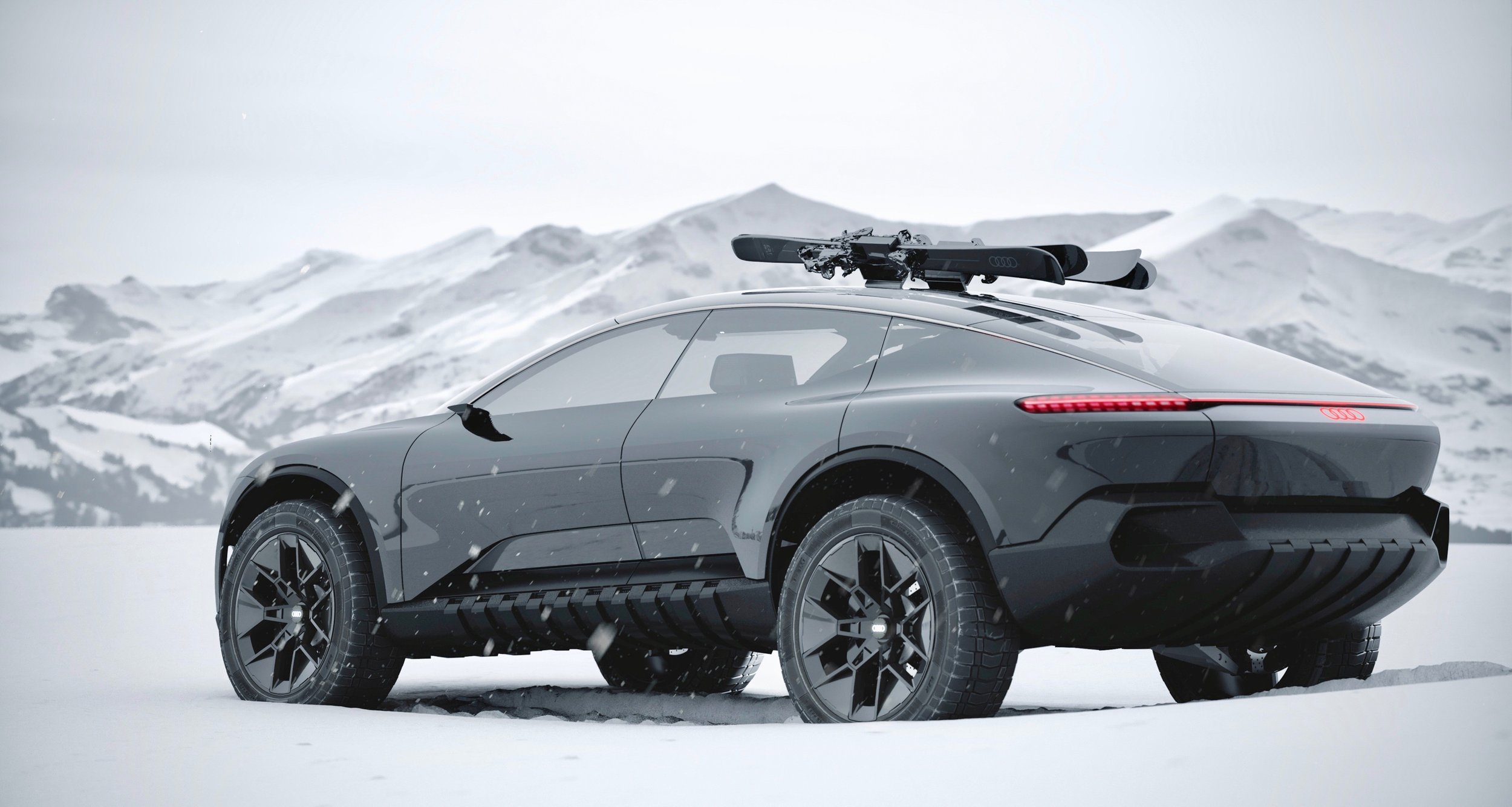Brave New World
If any of the big three German luxury car brands other than Audi had created the activesphere concept, eyebrows would have been raised. I say this with conviction because of this car’s clear lineage from three words that have been part of Audi’s brand vocabulary for decades: quattro, Allroad and Sportback.
The launch of the Audi ur-quattro in 1980 turned the road and rally car world on its head when the Ingolstadt-based car manufacturer delivered the world’s first mass-production car with permanent four-wheel-drive. The quattro name was soon writ large in lights as the revolutionary turbocharged Coupe pummeled the opposition in the World Rally Championship. The unerring traction advantage of 4WD in the hands of rally stars Hannu Mikkola, Stig Blomqvist, Walter Rohl and Michèle Mouton was clear for all to see.
Thanks to these rally successes, ‘quattro’ quickly because a household word synonymous with all-weather traction, and the higher specification Audi models offered with this system quickly became popular in countries with harsh winters.
The 1980s saw the arrival of the Audi 200 Avant quattro, a turbocharged estate car that used 4WD to help it dispense its 200hp through all-weather traction. The Audi RS6 Avant arrived in 1997, using 4WD traction as a performance aid to help keen drivers more effectively deploy the 450hp mustered by its twin-turbo 4.2 litre V8.
Audi cleverly capitalised on the base platform yet again in 1999, raising the ride height for light off-road capability with the first generation A6 Allroad quattro. Gaining a following with buyers who eschewed bulky SUVs but required a slightly raised ride height for light off-road work. The popular Allroad formula continues to this day with the current fourth generation A6 and the smaller A4 Allroad, now in its third generation.
The third established Audi design motif is the Sportback, which first debuted in 2004 on the A3, and is epitomised by the sleek four-door coupé styling on the A5 Sportback and A7. Mix this rich history of versatile 4WD Avant Allroad quattro and A7 models, add an electric motor on each axle and project it forwards a generation, and you have the activesphere concept. Audi calls this new body variant “active Sportback”.
A full-size luxury model, the activesphere concept is a sleek crossover coupé based on Audi’s innovative flagship Premium Platform Electric (PPE) drive system. Like the Audi grandsphere and Audi urbansphere concept cars that debuted in 2022, the activesphere concept draws on this modular system for series production.
PPE is the first platform designed to accommodate a wide range of premium models from high ground clearance SUVs and CUVs to the A6, the core Audi model with almost identical external dimensions and wheelbase to the Audi activesphere concept.
PPE is designed exclusively for battery-electric drive systems and leverages the advantage of this technology to enhance driving dynamics, economy, and package options. Developed together with Porsche AG, under Audi’s leadership, the first PPE-based Audi production vehicles will debut before the end of this year.
The key element of these forthcoming models is a battery module between the axles, which in this case holds around 100kWh of energy, and utilizing the entire width of the car between axles makes it possible to achieve a relatively flat layout for the battery.
An electric motor on each axle makes for a total output of 325kW, with a system torque of 720Nm. Range anxiety and charging are clear and present problems for EV owners. Thus, the heart of the drive technology in all future PPE models will be the 800-volt charging technology, which ensures that batteries can be charged very rapidly with up to 270kW at fast-charging stations.
This PPE technology enables charging times that come close to a conventional refueling stop for a combustion engine car, with just 10 minutes of charging being sufficient to load enough energy to power the car for over 300 km. The 100-kWh battery can be charged from 5 to 80% in under 25 minutes, and if you start with a full battery the claimed range is over 600km.
To optimise ride and handling the engineers use a five-link independent suspension system with an adaptive air suspension unit and adaptive damper at each corner. For off-road use the ride height can be raised at the touch of a button. The Audi activesphere’s ground clearance is also variable; ideal for off-road use, it can be increased by 40mm from the basic height of 208mm, or lowered by the same amount, which benefits both the center of gravity and aerodynamics at speed.
Its dimensions - 4.98m long, 2.07m wide, and 1.60m high - make the Audi activesphere concept a member of the premium segment. Typical of an electric car, the wheelbase of the 4.98m long activesphere is a generous 2.97m, providing maximum legroom for occupants.
The relatively short front and rear overhangs make the car look more compact while aiding approach and departure angles off-road. The former is 18.9˚, with the latter at 28.1˚.
Other design elements that gives the car its purposeful stance are the 22-inch wheels and raised ground clearance. The counterpoint is the sleek roofline with its dynamic arch that give the upper half of the car the proportions of a sports car.
While the beefy 285/55R22 all-terrain tyres reinforce the cars off-road ability, the alloy wheels are designed to aid efficiency on the blacktop. They feature movable segments that open for optimum ventilation off-road, and then close for optimum aerodynamics when cruising on normal roads. The elegant, stylish camera mirrors on the two front doors are also designed specifically to minimize drag.
Glazed surfaces make up a significant part of the vehicle’s body. A glazed nose panel mimics Audi’s Singleframe grille, giving front seat occupants an unobstructed view through the large frunk to the road in front. Metal strips with slightly offset vertical studs, arranged parallel to one another, are integrated along the lower body. These elements deploy when the ground clearance is increased, visualising the off-road mode.
Glass panels in the lower door area help to dissolve the boundary between the interior and world outside when the activesphere is in off-road mode. The wide, curved tailgate features extensive glazing, while the transparent roof panel lets abundant daylight into the cabin.
An overwhelming sense of light and space greets you as you climb into the spacious interior of the Audi activesphere through doors hinged from their front and rear edges with no intrusive B-pillar. The four individual seats are suspended like extensions of the high, full-length center console. The designers imagined the seat, back, and shoulder surfaces as three separate, circumferential shells. While their appearance hints at good lateral support, these seats also appear physically light and maintain a balance between automotive function and the elegance of a lounge chair.
When the Audi activesphere concept is in autonomous driving mode, the dashboard, steering wheel, and pedals disappear into the front of the cabin, further enhancing the sense of space. From the front seats especially, your perception extends to the front end of the activesphere and beyond, while the fully glazed Singleframe gives all occupants an unobstructed view of outside world.
If the driver wants to take over the wheel, the instrument panel along with the steering wheel, swivel out from their flush position below the windscreen. The MMI touchless controls in the doors are always accessible to the eye and the hand, for example to control windows and seat adjustments. The dashboard works like a large soundbar through the wood as well as a smart, full-width air-vent in both the deployed and stowed position.
The roof console that mirrors the centre console in its dimensions, holds the four AR headsets for the mixed reality system that combines physical reality and the digital sphere to create the new world of Audi dimensions.
Previously VR goggles were limited to depicting a virtual reality without any real-world elements. However, technology evolved into augmented reality, whereby the real world is superimposed with virtual content. Now, Mixed Reality is able to depict virtual content with 3D spatial reference to the real world.
The user can view virtual content, initially for information only. If the user then focuses with his or her eyes on the information, thus signaling interest, the system displays more detailed information. Content becomes an active and interactive element as soon as the user is focused and engages, i.e., with gestures.
This means the hand can then intuitively follow the user’s gaze to control on-board functions, while the user interface (the virtual display in the headset) reacts to changes in real time like a conventional instrument. A particularly user-friendly feature, the virtual control moves towards the user so that he or she can interact comfortably with the user interface, regardless of sitting position.
A specific control only appears when it is required, and can be operated just as intuitively as it would be in the real world. A key point is that the diverse functions of the car are not organised in the typical way they are today in a car with screens and physical function. Instead they are located logically right in front of the elements they are related to. Thus, the air-conditioning control ‘hovers’ in front of the air-vent, while the entertainment and sound interactive panel ‘hovers’ over the speakers.
However, the possibilities of this technology are by no means exhausted. In off-road mode, for example, high-resolution 3D topography graphics can be projected onto the real landscape and information on navigation and the destination can be displayed. Traffic safety information, i.e., alerts for traffic jams or slippery roads, can also be used here.
Depending on their needs, passengers and drivers are provided with very individual content in their respective mixed reality headset. With the driver concentrating on steering while active behind the wheel, passengers can begin looking into and even preparing activities at their destination.
Conversely, the activesphere passenger can take his or her headset out of the car and onto the ski slope to help navigate a trail or to find the ideal descent path when skiing downhill.
Information about the car itself, the battery range, and the nearest charging stations can also be accessed from both inside and outside the vehicle. And there are also advance warnings of safety related things like low tyre pressures, as well as a weather forecast function as a criterion for selecting a route.
As Oliver Hoffmann, Member of the Board of Management for Technical Development says, “The sphere concept vehicles show our vision for the premium mobility of the future. We are experiencing a paradigm shift, especially in the interior of future Audi models. The interior becomes a place where the passengers feel at home and can connect to the world outside at the same time. The most important technical innovation in the Audi activesphere is our adaptation of augmented reality for mobility. Audi dimensions creates the perfect synthesis between the surroundings and digital reality.”











